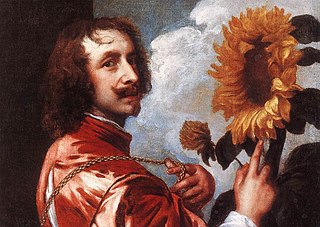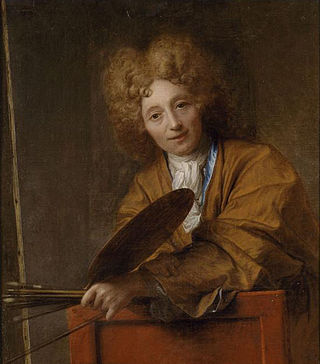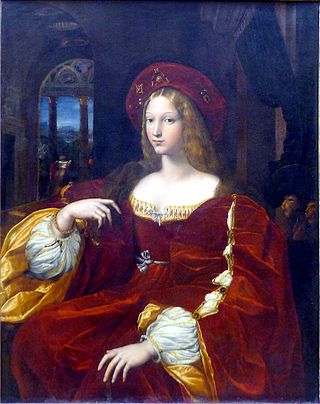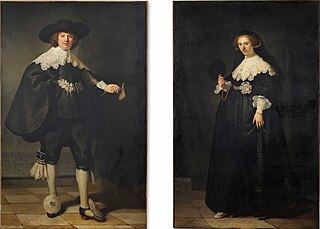
Jacint Rigau-Ros i Serra, known in French as Hyacinthe Rigaud, was a Catalan-French baroque painter most famous for his portraits of Louis XIV and other members of the French nobility.

Sir Anthony van Dyck was a Flemish Baroque artist who became the leading court painter in England after success in the Spanish Netherlands and Italy.

Simon Vouet was a French painter who studied and rose to prominence in Italy before being summoned by Louis XIII to serve as Premier peintre du Roi in France. He and his studio of artists created religious and mythological paintings, portraits, frescoes, tapestries, and massive decorative schemes for the king and for wealthy patrons, including Richelieu. During this time, "Vouet was indisputably the leading artist in Paris," and was immensely influential in introducing the Italian Baroque style of painting to France. He was also "without doubt one of the outstanding seventeenth-century draughtsmen, equal to Annibale Carracci and Lanfranco."

Antoine Coypel was a French painter, pastellist, engraver, decorative designer and draughtsman. He became court painter first to the Duke of Orléans and later to the French king. He became director of the Académie Royale. He was given the title of Garde des tableaux et dessins du roi, a function which combined the role of director and curator of the king's art collection. He was raised to the nobility by the French king. He is known for his history paintings, biblical, mythological and allegorical works, portraits and genre scenes.

Pierre Mignard or Pierre Mignard I, called "Mignard le Romain" to distinguish him from his brother Nicolas Mignard, was a French painter known for his religious and mythological scenes and portraits. He was a near-contemporary of the Premier Peintre du Roi Charles Le Brun with whom he engaged in a bitter, life-long rivalry.

Jean-Baptiste Lemoyne was a French sculptor of the 18th century who worked in both the rococo and neoclassical style. He made monumental statuary for the Gardens of Versailles but was best known for his expressive portrait busts.

Jean-Baptiste Santerre was a French painter and draughtsman of the Style Louis XIV, known for his history paintings, portraits, and portrait-like genre subjects. Considerably influenced by Italian masters of the Bolognese school as well as his French contemporaries, Santerre nonetheless made an original contribution in his art, being among the first French painters to bring Netherlandish influences.

Charles-Antoine Coypel was a French painter, art commentator, and playwright. He became court painter to the French king and director of the Académie Royale. He inherited the title of Garde des tableaux et dessins du roi, a function which combined the role of director and curator of the king's art collection. He was mainly active in Paris.

Charles Errard the Younger was a French painter, architect and engraver, co-founder and later director of the Académie Royale de Peinture et de Sculpture. In 1666 Louis XIV's minister Jean-Baptiste Colbert sent him to found the Académie de France à Rome, where he was director until 1684.
Gui Rochat is an international private art dealer and consultant, dealing primarily in seventeenth- and eighteenth-century French paintings and drawings, working from New York as "Gui Rochat Old Masters". His long experience with four art auction houses, Sotheby's, Phillips, Son & Neale, Butterfields and Doyle New York has given him the background for rescuing a number of Old Master paintings from oblivion. He is proud to have Antoine Le Grand Batard de Bourgogne (1421-1504) *, painted by Rogier van der Weyden as well as by Hans Memling, as a direct ancestor.
Arthena or Association pour la Diffusion de l'Histoire de l'Art is a French company which regularly publishes art history books and most particularly catalogues.

Sir Peter Paul Rubens was a Flemish artist and diplomat from the Duchy of Brabant in the Southern Netherlands. He is considered the most influential artist of the Flemish Baroque tradition. Rubens's highly charged compositions reference erudite aspects of classical and Christian history. His unique and immensely popular Baroque style emphasized movement, colour, and sensuality, which followed the immediate, dramatic artistic style promoted in the Counter-Reformation. Rubens was a painter producing altarpieces, portraits, landscapes, and history paintings of mythological and allegorical subjects. He was also a prolific designer of cartoons for the Flemish tapestry workshops and of frontispieces for the publishers in Antwerp.

Charles I at the Hunt – also known under its French title, Le Roi à la chasse – is an oil-on-canvas portrait of Charles I of England by Anthony van Dyck c. 1635, now in the Louvre Museum, Paris. It depicts Charles in civilian clothing and standing next to a horse as if resting on a hunt, in a manner described by the Louvre as a "subtle compromise between gentlemanly nonchalance and regal assurance".

Charles I with M. de St Antoine is an oil painting on canvas by the Flemish painter Anthony van Dyck, depicting Charles I on horseback, accompanied by his riding master, Pierre Antoine Bourdon, Seigneur de St Antoine.

Portrait of Doña Isabel de Requesens y Enríquez de Cardona-Anglesola is an oil painting dated circa 1518 that was formerly believed to depict Giovanna d'Aragona. It has been variously ascribed to Raphael, Giulio Romano, or the school of Raphael; it is now usually taken to have been executed by Giulio Romano based on a sketch by Raphael and then altered by Raphael. The painting is now in the Louvre Museum in Lens.

The pendant portraits of Marten Soolmans and Oopjen Coppit are a pair of full-length wedding portraits by Rembrandt. They were painted on the occasion of the marriage of Marten Soolmans and Oopjen Coppit in 1634. Formerly owned by the Rothschild family, they became jointly owned by the Louvre Museum and the Rijksmuseum in 2015 after both museums managed to contribute half of the purchase price of €160 million, a record for works by Rembrandt.

Everhard or Eberhard Jabach was a French businessman, art collector and director of the French East India Company. He was born in Cologne in the Holy Roman Empire but later naturalised as a French subject.

Jesus Insulted by the Soldiers is an 1865 oil on canvas painting by Édouard Manet, his last religious work. It is now in the Art Institute of Chicago, to which it was left in 1925 by James Deering, heir to the Deering Harvester Company.

Portrait of Francisco de Moncada is a 1634 oil on canvas portrait of Francisco de Moncada by Anthony van Dyck, commissioned simultaneously with the equestrian portrait of the same subject now in the Louvre. Since at least 1720 it has been in the Kunsthistorisches Museum in Vienna.

Luigi Cherubini and the Muse of Lyric Poetry is an 1842 oil-on-canvas allegorical portrait of Luigi Cherubini by Jean-Auguste-Dominique Ingres and his then-pupil Henri Lehmann. It was bought from Ingres for 8,000 francs by Louis-Philippe I using civil list money in June 1842 and given to the musée du Luxembourg, before being moved in 1874 to the Louvre Museum, in whose collections it still resides.


















